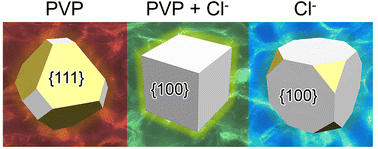Solution-phase synthesis of metal nanocrystals with multiple additives is a common strategy for control over nanocrystal shape, and thus control over their properties. However, few rules are available to predict the effect of multiple capping agents on metal nanocrystal shapes, making it hard to rationally design synthetic conditions. This work uses a combination of seed-mediated growth, single-crystal electrochemistry, and DFT calculations to determine the roles of PVP and Cl− in the anisotropic growth of single-crystal and penta-twinned silver nanocrystals. Single-crystal seeds grow into truncated octahedra bounded by a mixture of {111} and {100} facets in the presence of 0.03–30 mM PVP, but when 3–6 μM Cl− is added with PVP, the single-crystal seeds grow into cubes bounded by {100} facets. Electrochemical measurements on Ag(100) and Ag(111) single-crystal electrodes show PVP is a capping agent but it exhibits no selectivity for a particular facet. Addition of Cl− to PVP further passivates Ag(100) but not Ag(111), leading to conditions that favor formation of nanocubes. DFT calculations indicate the preferential binding of Cl− to Ag(100) causes preferential binding of PVP to Ag(100). The combined results indicate the presence or absence of Cl− modulates binding of PVP to (100) facets, leading to the formation of nanocubes with Cl−, or truncated octahedra without it.
